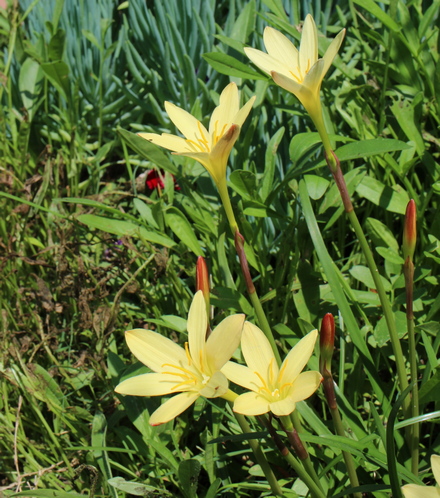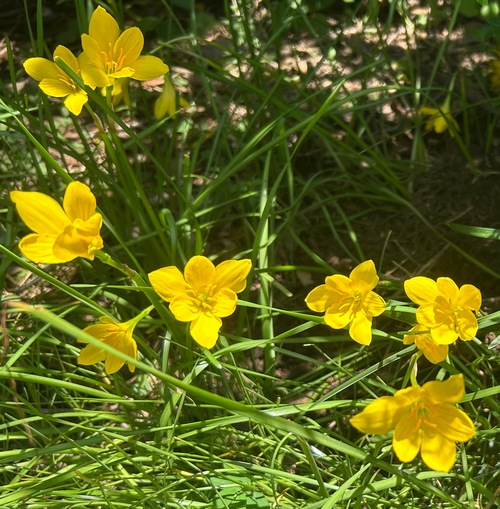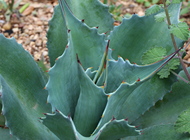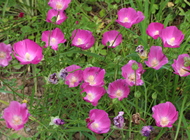The glory of rainlilies
Perennial gardening in Houston is a challenge. Few of the herbaceous species I grew in Pennsylvania can cope with the hot and humid summers here – acting as short-lived perennials at best, but more often as single-season plants. On the other hand, the tropicals sold here survive the summers, but only some of the winters – when we get one of our polar vortexes (on average, about once every two years since we've lived here), they tend to disappear. And most of the real natives, who can handle both the heat and the cold, are underwhelming in appearance or have overly aggressive tendencies (such as the lovely but uncontrollable Texas evening primrose). Among the few exceptions to my general lack of success with perennials here has been the performance of many kinds of rain lilies. So it's about time I devote a page to them! Generally, the common name rain lilies is used to refer to three genera: Zephyranthes, Habranthus, and Cooperia. Of these, botanists have recently decided that only the first is worthy of genus status, while species in the other two genera have been relocated to Zephyranthes. I've never grown Cooperia species, but have tried various members of Habranthus. Since I still think of them that way, I'll refer to these by both their Habranthus and Zephyranthes names on this page; two of my three favorite online taxonomic references still consider Habranthus to be current, but that may change in future updates. The distinctions of Habranthus previously recognized vs. Zephyranthes were that the former holds its flowers at an angle to the stem of outward-facing, whereas the latter holds them upright, and that its stamens are of unequal lengths. Regardless of taxonomy, all rain lilies hail from the Americas, with different species finding their origin in broad swaths of South America, throughout Central America and Mexico, and into the southern parts of the United States. Some species are native to Texas, which explains their robust performance – but many others do very well too, even those whose native range is more tropical. Not all of them go by the common name "rain lily" (H. tubispathus, for example, goes by "copper lily"), but to me they all belong together, and are collectively rain lilies. Their flowers (see gallery below) range from pure white through various shades of pink to yellows, and in size from under an inch to more than two inches across. Some grow no taller than 8 inches, while others rise well over a foot. Most have narrow strappy leaves that resemble some clumping alliums more so than a clump of grass; but a few go even narrower, achieving a grassier look, especially when they colonize a stretch of the border. I try to document most of these features in photos and descriptions below. CultivationMost rain lily species I've grown have proven quite robust in the garden. They are not very popular as ornamentals, probably because their bloom times are unpredictable, and they are simply green clumps when not in bloom. But green clumps aren't bad – and for some of the more assertive species, I consider the evergreen grassy foliage to be an asset towards the front of my borders. The plants grow from chunky bulbs, up to an inch or so in diameter, and tend to enlarge their clumps by forming offsets from the mother bulbs. They are easy to transplant: the bulbs establish themselves a few inches below the soil – making it easy to get both the bulbs and the beard of roots below with a good trowel. And they don't demand any supplemental water once they're established. A few species I've grown are smaller, finnickier, or just less robust. Consequently, after some years of collecting any species I could find seeds of, my garden clumps have favored the strong ones. But those small species have their own charm, so I try to increase their number, and reintroduce them when they don't survive, hoping to find better growing conditions in which they'll eventually thrive. I'll note my observations in the descriptions below. True to their name, most rain lilies burst into flower after a good downpour ends a period of dryer weather. I haven't been able to reproduce this with a garden hose, so there's a bit of natural magic involved – which is fine by me. Even so, not all rain lilies come into bloom simultaneously after such events, so once I had a fair number of species going, there was usually some rain lily in bloom between mid-spring and mid-autumn. Perhaps I'll figure out the pattern sometime. Having this page will be an incentive to do so! Propagation
Nearly all of my rain lilies came to our garden as seed (mostly from the
annual NARGS seed exchange). The seeds pretty much all look alike: flat
black wafers that often seem too thin to contain the beginnings of life (but
germinate just fine anyway); the photo here shows a pod full of Z.
drummondii seeds. They are somewhat fragile, prone to breaking in half, and
partial seeds are unlikely to be viable. I've found that they are generally
quite easy to get going from seed, requiring no special treatment, and doing
nicely in seedling pots for a few months before setting out into the garden.
I exclusively use my baggy method, in which
germination (first appearance of a seed root) tends to occur in 4-7 days,
with high germination percentage for fresh, undamaged seeds. The photo below
shows two sprouted Z. drummondii seeds on filter paper, a few days after
germination. I'm sure that
germinating them directly in potting soil would work just as well, although
you'll have to wait longer to see signs of life, since emergence of top
growth takes a little longer.
Once germinated in the baggy, I find that there is no rush to get them into soil; the seeds are perfectly happy to continue to develop in their moist paper environment, so I often wait till there are a sufficient number germinated for me to pot them up all in one go. My standard procedure is to put nine germinated seeds into one four-inch pot with standard peat mix, in a 3x3 pattern, and setting the pot outside for development through winter and early spring (they come inside, along with all my other seedling pots, when overnight freezes threaten, but I'm not sure this is necessary). Around the time the weather gets hot in April, I separate them out (they have developed nice little bulbs by then), and give them some room in my garden's seedling nursery area, where they live for the following year. By the next spring, they have typically grown strong, with sizeable bulbs, and are ready to out into the wider garden. Many will bloom that second year, but in my experience some wait another year to do so. A gallery of flowersBefore getting to the specifics of each of the species and varieties I've grown, let's start with a simple flower picture gallery, arranged with similar flowers side by side. This may (or may not) help to elucidate some of the differences among the species. All species have six tepals (three petals and three sepals, which generally look the same), although some hybrids and cultivars may have more, and six yellow anthers.
A walk-through of the species I've grownLet's take a look at each species and variety in turn. The headings are links to the full pages on this site, which provide more photos, seed-starting information, and other details. Zephyranthes macrosiphon (and fosteri)
I consider this species from eastern Mexico one the prettiest in its pink simplicity. It's a smaller species with fairly narrow, pointed petals colored sweet baby pink, with the golden stamens held aloft in the center. It is among the smaller ones I've grown, with its 2-3-inch flowers rising to about 10" tall, well above the lower-growing clump of grassy leaves. Not the strongest grower, but we have several clusters growing, and their sporadic blooms are always a welcome sight. The photo here was taken shortly after a nice thunderstorm, when every single representative of this species in our garden burst into bloom. I have now also grown plants from seed labeled Z. fosteri. The flowers from those plants more strongly resemble my Z. macrosiphon than they do the Z. fosteri (another species from Mexico), which shares the same color family and pointed petals, but with more compact flowers and chubbier tepals. So this may be one of several cases of mistaken identity lurking among my rain lilies. Zephyranthes katheriniae
Among those we've grown, this one comes closest to a red flower, although its small flowers are best described as fuchsia or magenta. Definitely unique among the ones I've grown, and the petite cup-shaped flowers are quite charming. The plants stay small – the photo here shows four-year-old plants that are finally producing more than one flower per bulb, but growing to no more than 8" tall, they are still easily overwhelmed by other plants growing taller around them. Native to central Mexico. Zephyranthes 'Lubuffarosea Group'
Closing out the series of Zephs in the pink color family, this is the only non-seedgrown rain lily in my collection. It is a sterile hybrid (at least, I've never seen it set seed) that I purchased at the Peckerwood Garden (now John Fairey Garden) nursery, which shares a history with the old Yucca Do nursery in the same location. This strain was reportedly a collection named by Yucca Do; its parentage is unknown. In any case, they still multiply through their bulbs, and have generally done well, some years making a magnificent display after a good thunderstorm, while taking a back seat in other years. I like the soft look of the flowers, lent to them both by the blush pink coloration and the pillowy texture of the petals. Zephyranthes dichromantha or primulina
Occurring naturally in northern Mexico, this is one of the first species I grew (from seed labeled Z. dichromantha), and still one of the most prolific. I like the subtle reddish markings on the reverses of the soft yellow flowers. In time, they form a strong patch of foliage, multiplying both by bulb offsets and by seeds (including into my lawn). By now, I have patches in various locations around our garden, and it is reliably among the species to spurt into bloom after a good rainstorm. A few years after establishing this in my garden, and still on a drive to grow all the rain lilies I could get my hands on, I started some seed of Z. primulina. When it bloomed a year or so later, I found it to be indistinguishable from what I regarded as Z. dichromantha. The primulina species is more widely described and grown, and its photos and descriptions tend to match my plants, so I suspect I was initially wrongfooted. That means I'm still looking for the actual dichromantha, which shares the same origin in Mexico. Judging from the few photos I've been able to find, its flowers lack the reddish accents (which is odd, because the "dichromantha" name suggests to me there should be two colors involved), and have a somewhat brassier shade of yellow; they also reportedly bloom later (mine are among the first rain lilies to flower, typically in April). So I'll stay on the lookout for them. Zephyranthes citrina
This species, with its bright lemon-yellow flowers, is well named. The flowers are fairly small (no more than an inch across), and are held low above the plants' lax grassy foliage. Over time, it achieves the appearance of a meadow of pendulous grass. I find that this is less floriferous than some of the others I've grown – and yet it manages to seed itself around fairly prolifically; according to some information I've found online, it can set seed asexually and abundantly, which undoubtedly helps it further its expansionist ways. Since my main patch lives just outside of my seedling nursery area, I'm always extracting its bulblets from my nursery beds (which means I sometimes need to decide whether bulbs I've just dug up belong to this, or to some plant that I put there on purpose. This is when some bulb identification skills can come in handy (see subterranean section below). Native to Mexico's Yucatan peninsula. Zephyranthes drummondii
Native to Texas as well as New Mexico and Mexico, this species is known as giant prairie lily, among other common names. It is among the more robust ones in our garden, with substantial strappy bluish-gray-green leaves and flowers large enough to make a statement on their own (but they're very nice clustered, too). Although some references say the flowers may have some pink margining, ours have been consistently pure white, with longish somewhat pointy tepals splayed open to a nice effect. The tallest white zephs in our garden, with flowers rising about a foot high, well above the leaves which are long but whose lax habit keeps them lower. Easy to grow from seed, and reseeds in our garden, too – but may take a couple years to reach blooming size. Zephyranthes morrisclintii
A lower-growing white-flowered species, apparently a natural hybrid between Z. drummondii and Z. lindleyana orginating in northern Mexico. I've seen photos of both pink and white specimens; ours (grown from NARGS seed) has pink buds that open to nearly pure white flowers composed of very thin, nearly translucent tepals, which eventually fade to show a bit of pink blush. They grow no more than 8" tall for us, with fairly narrow, mid-green leaves not at all reminiscent of Z. drummondii, and the flowers are chubbier with more of a cup shape. Often the first species to bloom in our garden as the season gets started. Zephyranthes sp.
The last one in the series of whites I know simply as "species from Tamaulipas", which is how it was described in the NARGS seed exchange list. It is about the same size as Z. morrisclintii, but has more pink accents throughout the life of the flowers. Habranthus robustus = Zephyranthes robusta
Turning now to the clan that until recently was known as Habranthus, probably the most commonly grown is this larger species from Argentina with blowsy soft-pink flowers, growing from robust clumps of strappy leaves. They start a little later than most other species in our garden, but when they do it's a spectacular sight. I find that they readily multiply by bulb offsets, and they also self-seed in the areas where they grow most happily. This is one of the only rain lilies I managed to grow back in Pennsylvania, but there I had to bring its pot into the garage for winter; here in Texas they are perfectly hardy. You can see the more outward-facing position of the flowers compared to the zephyranthes above, which always look upward. Habranthus tubispathus = Zephyranthes tubispatha
The second Habranthus is quite a different plant: much less foliage on a much smaller plant, with smaller flowers in a brassy yellow color with orange-red center, which accounts for its common name, copper lily. The flowers again face up- and outward. Its habit is to produce just one flower per bulb, and generally much less assertive than H. robustus, which probably explains why I haven't taken many pictures of it through the years I've grown it. The photo shown here is of a patch enlarged by self-seeding, which burst into bloom in late May, a few days after a big thunderstorm drenched the garden. There's only flower stems at this point, with foliage developing only later. Not all of the clusters I've set out through the years have survived – this species may be more particular about drainage in winter, or conversely more susceptible to drought, as it grows naturally in moist areas in Texas and other areas around the Gulf of Mexico and the Caribbean Sea. We've certainly experienced both winter-wet and summer-dry in recent years. In any case, I'm glad to see them when they show themselves, as they are distinctively different from the other species in our garden. Other speciesSince I've thus far limited myself mostly to what's popped up on the NARGS seed lists, I've grown only a fraction of the species, and hardly any of the hybrids (Plant Delights Nursery grows and offers a nice selection of both species and hybrids). Among the more commonly grown ones that are still missing from my pallette are Z. grandiflora (a somewhat larger version of Z. macrosiphon, it appears), Z. lindleyana and Z. regina (both of which I've tried and may still see flowers of), and Z. candida, a white-flowered species whose range includes the southern US. I hope to be able to add to this page in years to come. Kew Plants of the World Online recognizes 195 species of Zephyranthes (they've lumped in all the former Habranthus), so I have a ways to go! Zephyranthes bulb identificationThe tendency of rain lilies to seed themselves around is generally a blessing – but it can be frustrating to a gardener who likes to know what's growing where, especially since they bloom only sporadically, and often not in tandem, making identification of stray groupings a challenge. So I wondered if it would be possible to draw clues from a part of the plant that can always be inspected: its bulb and lower foliage. So I'm making a bit of a project out of that, snapping photos whenever I uproot a clump of known identity for transplanting. The results are shown below – I think the verdict is out how helpful these features are in identification. All species I've inspected have at least partially black/dark-brown bulbs, with some variation in the shape of the lower bulb as well as its attachment to the lower leaves, and the lower leaves themselves. Take a look and judge for yourself.
Further reading
I welcome comments about my web pages; feel free to use the form below to leave feedback about this particular page. For the benefit of other visitors to these pages, I will list any relevant comments you leave, and if appropriate, I will update my page to correct mis-information. Note that I discard any comments including html markups, so please submit your comment as plain text. If you have a comment about the website as a whole, please leave it in my guestbook. If you have a question that needs a personal response, please e-mail me.
Last modified:
June 22, 2025 |
|||||||||||||||||||||||||||||||||||||||||||||||||


















